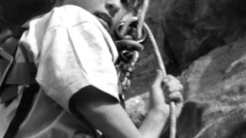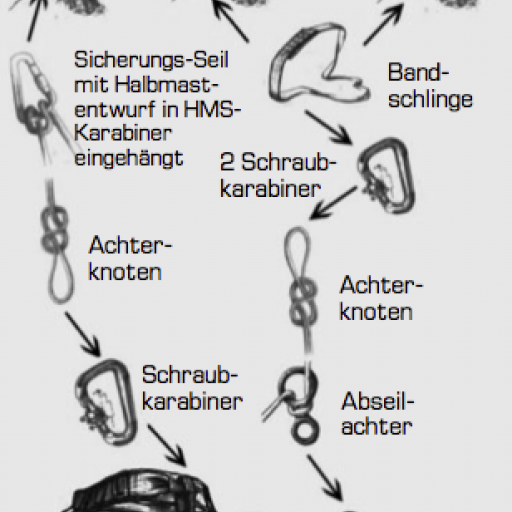Relay? No! No way. That's way too dangerous, and what could happen there!
We want to show you that abseiling doesn't have to be any more dangerous than playing cross-country in the woods. If you observe the basic safety precautions, then abseiling becomes a good and special event that will be remembered for a long time.
See PDF file
for complete article with pictures of knots, carabiners, etc
Short guide to successful abseiling
First you should look around for a suitable terrain. Take enough time to do this, because a good abseiling spot is half the battle. Think about how high the abseil point should be, as it is very important for the participants whether they abseil over a small wall of ten metres or over a rock face of 30 metres. Once you have found a spot, ask yourself the following questions:
- Are there enough options to secure the rappel spot?
- Do at least the rappeller and the belaying leader have a large enough stance without endangering themselves and others?
- Is there a safe approach to the abseil site, i.e. can your participants reach the abseil site without danger?
Look for a place that offers the possibility to otherwise occupy the children, which just can not abseil. Of course, an exciting abseil site (for example, next to a waterfall, in a place with a good view) is much more interesting for the participants than if you abseil on a clay slope in the dark forest. If you have children with you who have never abseiled before and are anxious as a result (which is also very likely), then make sure that there is a slope nearby that is not too steep on which to practice abseiling.
Rope attachment / belay
Now that you've found the ideal spot, it's time to set up the rappel point (See Fig. p. 26). To do this, you will need at least two bombproof attachment points such as two healthy trees, a railing set in concrete, or something similar. Now the rope is attached to the attachment points with the help of two webbing slings (when setting up the belay, you should ensure that all belay points are redundant, i.e. double). It is important that the belayer has a good position (attention: falling rocks, danger of slipping etc.). Furthermore, communication between the abseiler and the belayer must be guaranteed at all times, so that immediate action can be taken if problems arise. At the lower end of the abseil section should be another ladder person, the abseiling from the rope loosens and pays attention to the fact that uninvolved persons are not in the abseil zone.
Relaying
Now you finally bus ready and can send the bravest person on the journey. After the "Gschtältli" has been tightened, you hang the abseiling eights in the rope and then attach it to the Gschtältli with a screw carabiner (always screw the carabiner shut). With another carabiner you can attach the safety rope to the Gschtälti. Secured is now with the help of a half-mast throw and an HMS carabiner, which is hooked on the anchorage.
The posture when rappelling is generally with the feet perpendicular to the wall, legs stretched through and slightly spread (opening angle about 45 °). This prevents you from tipping over sideways. Now you have to work your way down slowly, step by step, until you have safe ground under your feet again. At the latest now a high feeling comes over you, mixed with a portion of relief.
Basic
Safety
When you abseil with children, the responsibility is great, you must be aware of this. Abseiling should first be tried out by the leadership team before running a Jungscharn afternoon. Maybe you know an experienced person in your circle of acquaintances who will help you with it.
The following points in particular to pay attention to when abseiling:
● Long hair / clothes:
Once these come between the rope and abseiling eights, it will be difficult and pretty sure painful to undo. Also necklaces or similar can be fatal
Stone chipping
When selecting the terrain, make sure that no stones can break out (Nagelfluh is therefore conceivably unsuitable for abseiling).
General redundancy
All elements should be doubled if possible. For example, attach the rope with two screw carabiners (see illustration). A separate anchorage should be chosen for the second rope, which is used for belaying people. Make sure that the carabiners are screwed
Friction heat
Heat is generated between the rope and the abseiling chute. Depending on the rappel speed, this heat is enough to cause the rope sheath to melt. Once at the bottom, the descender should be immediately separated from the rope.
Material
The material is of great importance when rappelling. When renting equipment, always make sure that it is in good condition. You should know where the material comes from and what it has been through. Especially with rope and carabiners, falls can cause invisible cracks. If this is the case, you better take another rope, another carabiner.
- Rope:
Unlike climbing, where only climbing ropes (dynamic ropes) are used, you can also use static ropes for rappelling. You should not abseil with hemp ropes.
- Relaying equipment:
In the normal case, one rappels with a rappelling eight. There is also still a whole range of special equipment, which is however only conditionally suitable for children.
- Carabiners:
Only HMS carabiners should be used (characteristic: pear-shaped). In addition, the carabiners must have a locking device (screwgate, TwistLock, etc.)
- Gschtälti:
It is recommended to use combos. Make sure to have small combos for kids as well.
- Band slings
Band slings are highly resilient and to use for anchoring. In an emergency, a "Not-Gschtältli" can also be made with tape slings.
Advanced
Here is some more information about abseiling. If you are looking for that special kick, then you should rappel overhanging once, for example from a rock edge or an observation tower. The most difficult thing is to leave the ground with the feet and hang completely free on the rope.
Caution: We have already experienced that a child has suddenly broken out in panic. This can then mean that a lead person has to rope down to that child and then work their way down together with the child. However, this is the exception.
A child should always rappel voluntarily. Sometimes, however, you have to take away a child's fear of it a bit, and encourage him again and again to take the step over the edge. This does not mean coercion or peer pressure. Keep in mind that there are children who are afraid of heights. Here, all efforts will be in vain.
Noch something on the subject of seat belt. In climbing, the so-called seat harnesses are very common. When rappelling, however, it is important to note that you can fall out (in a fall upside down). For this reason, these seat harnesses should only be used in conjunction with a chest harness. Chest harness and seat harness tie together with a cord (figure of eight knot).
On the homepage of the JS Henggart (www.jshenggart.ch.vu) you can find a short movie with the topic abseiling for download. This film shows some impressions from one of these Jungscharnachmittage between heaven and earth.
Source reference
Content + Image:
Forum Child 1/04, Between Heaven and Earth. Various technical aspects around abseiling, pages 25 + 26 www.forum-kind.ch
Authors:
Andi Flückiger and Urs Bänninger, Jungschararbeit FEG Henggart
Content may be automatically translated. Help improve the quality of the translation with your editing!



